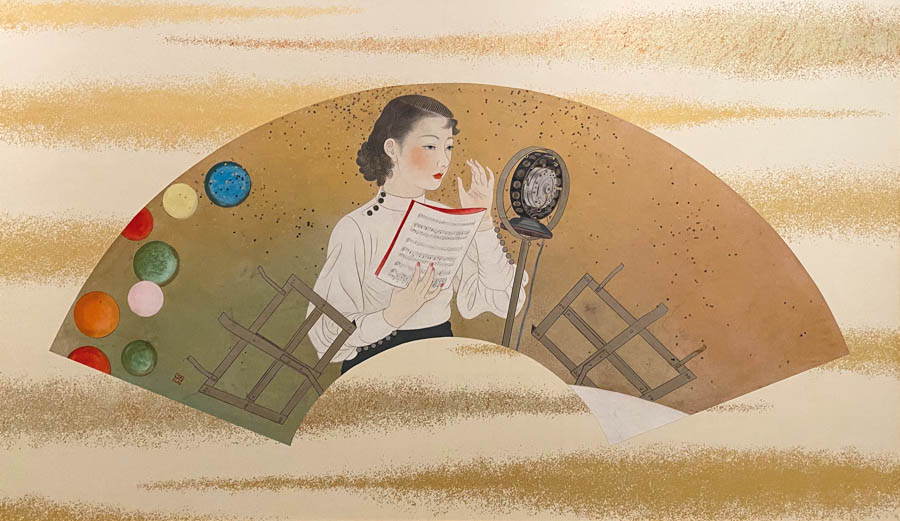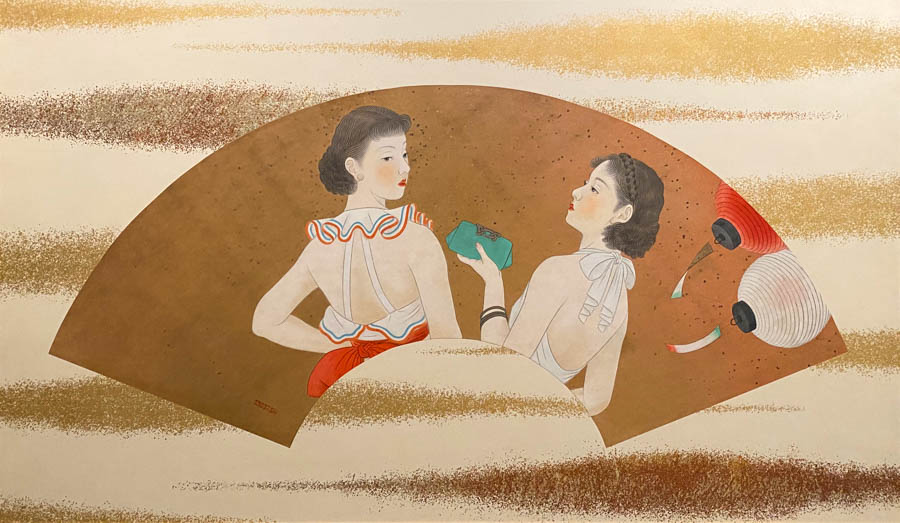Cigarette smoke hangs a thick curtain above the dance hall. Sweat flicks from your brow as bodies twist and turn at the corners of your vision, whirling in and out of sight. The raucous horns of a Jazz band reverberate in your ears, driving the chaotic mass. Tokyo’s elite look on from afar. Outside, the ever churning city churns on, unaware and uninvited to this spectacle of sound. Trudging towards their industrial alibi —disconnected from this youthful aura. But inside Ballroom Florida, you are connected. You are a part of something—a feeling, an energy, a movement of modernism that came crashing through the country like a tidal wave during Japan’s Jazz Age.
That energy is alive once again at The Ringling Museum’s Ballroom Florida: Deco & Desire in Japan’s Jazz Age. The exhibition features six paintings from celebrated Japanese painter Enomoto Chikatoshi and a photograph by modernist photographer Hamaya Hiroshi depicting the women and art deco atmosphere of the Ballroom Florida, along with various assorted objects reminiscent of the dance hall. “The subject of the paintings and photograph are ostensibly women who were employed at Ballroom Florida. The Ballroom Florida was famous for their very beautiful, stylish, and skillful Taxi Dancers—professional dancers who were paid on a per-dance basis by patrons of the club. Another painting features a woman who’s singing, likely a cabaret singer or jazz vocalist. Many of the women, however, are lounging and could have actually been patrons themselves,” says Rhiannon Paget, curator of Asian Art and Ballroom Florida: Deco & Desire in Japan’s Jazs Age at the Ringling Museum.

CURRENTLY ON EXHIBIT AT THE RINGLING MUSEUM'S BALLROOM FLORIDA: DECO & DESIRE IN JAPAN'S JAZZ AGE.
Established in 1928, Ballroom Florida quickly became one of the most prestigious of all of Japan’s jazz-age dance halls. The grandeur of the nightclub’s art-deco interior, its staff of attractive, skilled, “Taxi Dancers”, and penchant for booking the biggest names in jazz—both foreign and domestic—set it apart from other venues. “Ballroom Florida was one of the most foremost and stylish of Japan’s dance halls. It attracted a lot of celebrity and international clientele and drew a lot of business from the newly wealthy as well. The Florida had the most fashionable interior—they had the tubular Bauhaus style furniture, electric lights, and a fantastic stage. They also hired a lot of dancers - which were said to be the most beautiful and glamorous around. Not only did that attract male clients, but it also ensured that you always had a skilled dance partner for social dancing,” says Paget.
At its height, Ballroom Florida was emblematic of the pre-war modernism ushered in during Japan’s Jazz Age. Following the country’s rapid industrialization in the mid-19th century, Japan became a hub for cross-cultural influences with the Western world. Amongst the artistic and cultural interchange, were changes to the traditional Japanese social structure.
“Dance halls were a new kind of venue in the 1920s and 30s that allowed people to participate in social dancing, which is not traditional to Japanese culture. However, in the late 19th century, the Japanese elite saw that dancing was something that people did in diplomatic parties —it was a good way of cementing relationships. They realized that if Japan wanted to be a modern country, they had to offer this to diplomats and officials who were coming to Japan from the west,” says Paget.
Interest in social dancing filtered quickly out from official circles to the masses—and a younger, cosmopolitan population that was eager to embrace modern, westernized culture. A booming economy drove the development of multi-level department stores and the country’s first subway system—spawning a new generation of independent, socially liberated women that traditionally would have never left their families in the countryside. These women—or “Moga”, a contradiction of modern girl in Japanese— and their male counterparts, “Mobo” (modern boy) craved locations where it was socially permissible to interact with the opposite sex and indugle their interests in foreign music. Dance halls, like the Ballroom Florida, were just the place to do so.
The western influence didn’t stop with changing social trends. The Art Deco design of the Ballroom Florida was one of the stylistic trademarks of the night club and Japan’s Jazz Age as a whole. “Art deco really kind of became more rooted in Japan after 1925. 1925 was the year of the international exposition in Paris and a lot of Japanese artists, painters and also metal workers, ceramicists all went to that exhibition. That prompted an explosion of western-style art deco design. But of course, in Japan, they don’t just copy. They sort of took the principles of the style and applied it in ways that made sense and had meaning to themselves,” says Paget.
Ballroom Florida: Deco & Desire in Japan’s Jazs Age employs various objects and sounds of that art-deco design to create a multisensory experience reminiscent of the Ballroom Florida. “There are about 40 objects, which include ceramics, metalwork, cloisonné, lacquerware, and smoking sets, and also printed materials. We have about 15 song books–booklets of sheet music for harmonica or ukulele with really wonderful covers done by some quite well- known designers of the day who specialized in this type of graphic design,” says Paget.
Paget also supplements the exhibit with the music of Midge Williams—an African-American jazz vocalist who rose to prominence while performing at the Ballroom Florida. For as much as the dance hall was emblematic of the westernization of Japan’s social culture and design language, it was also just as famous for ushering in the biggest names in jazz from around the globe. “The Ballroom Florida was a multisensory space and their music was so famous that I wanted to cultivate a more immersive experience for the viewer,” says Paget. “Midge Williams was one of the real gems to emerge out of that era,” she adds. “ I’ve read that during her time, she was more famous than Billie Holiday, but unfortunately she died young and faded into obscurity,” says Paget.
The Ballroom Florida’s art deco style harkens back to what Paget describes as “constructed exoticism” —or taking the idea of what appears exotic and otherworldly and applying it to your own setting. Even the Tokyo dance-hall’s name “Ballroom Florida’’ is not of its own origin—but rather taken from a Parisian nightclub with the same moniker. “There are these two layers of exoticism. The Paris chic atmosphere of Tokyo’s Ballroom Florida and then obviously the Parisian place is named after Florida out of their own fascination with tropicality. I was curious about how this idea of creating your own exotic carries through to this venue, the Ballroom Florida, and then how you see that actually in other kinds of art deco visual and material culture,” states Paget. So why is it important to tell the story of a long-forgotten nightclub of a bygone era that operated halfway across the world? Why does the Ballroom Florida and the people that inhabited that space nearly 100 years ago matter?
It matters because people come to Florida, to Sarasota, to pursue their own version of paradise, to create their own idea of what’s exotic, different, and new. In a time in which we live as safely as we can in our perfectly curated realities, taking the time to experience an environment entirely foreign to our own —perhaps that of a nightclub in 1920s Tokyo—can allow us to expand the boundaries that we put upon ourselves. “It just makes the world a little bit smaller,” attests Paget.









